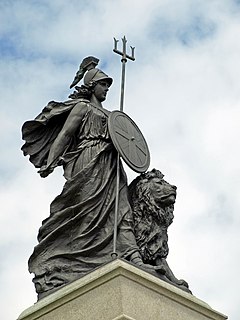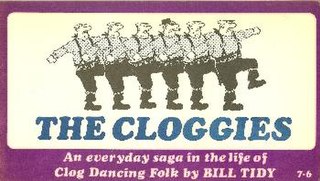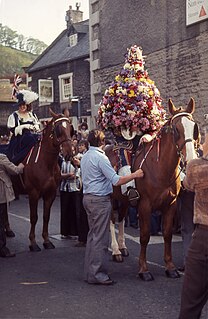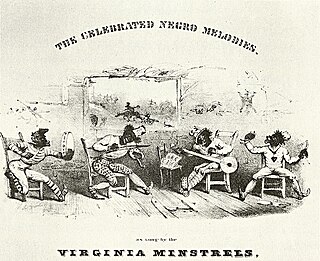
The Christian holy day of Pentecost, which is celebrated on the seventh Sunday after Easter, commemorates the descent of the Holy Spirit upon the Apostles and other followers of Jesus Christ while they were in Jerusalem celebrating the Feast of Weeks, as described in the Acts of the Apostles. In Christian tradition, this event represents the birth of the early Church.

The coconut tree is a member of the palm tree family (Arecaceae) and the only living species of the genus Cocos. The term "coconut" can refer to the whole coconut palm, the seed, or the fruit, which botanically is a drupe, not a nut. The term is derived from the 16th-century Portuguese and Spanish word coco meaning "head" or "skull" after the three indentations on the coconut shell that resemble facial features.

Morris dance is a form of English folk dance usually accompanied by music. It is based on rhythmic stepping and the execution of choreographed figures by a group of dancers, usually wearing bell pads on their shins. Implements such as sticks, swords and handkerchiefs may also be wielded by the dancers. In a small number of dances for one or two people, steps are near and across a pair of clay tobacco pipes laid one across the other on the floor. They clap their sticks, swords, or handkerchiefs together to match with the dance.

Britannia has been used in several different senses. The name is a Latinisation of the native Brittonic word for the island, Pretanī, which also produced the Greek form Prettanike or Brettaniai, which originally, in the fourth to the first centuries BC, designated a collection of islands with individual names, including Albion or Britain. In Modern Welsh the name remains Prydain. By the 1st century BC, Britannia came to be used for Great Britain specifically. After the Roman conquest in 43 AD, Britannia meant Roman Britain, a province covering the island south of Caledonia. When Roman Britain was divided into four provinces in 197 AD, two were called Britannia Superior and Britannia Inferior. Britannia is the name given to the female personification of the island, and it is a term still used to refer to the whole island.

Whitsun is the name used especially in Britain and Ireland, and throughout the world among Anglicans and Methodists, for the Christian festival of Pentecost, the seventh Sunday after Easter, which commemorates the descent of the Holy Spirit upon Christ's disciples. In England it took on some characteristics of Beltane, which originated from the pagan celebration of Summer's Day, the beginning of the summer half-year, in Europe. Whitsuntide, the week following Whitsunday, was one of three vacation weeks for the medieval villein; on most manors he was free from service on the lord's demesne this week, which marked a pause in the agricultural year. Whit Monday, the day after Whitsun, remained a holiday in Britain until 1971 when, with effect from 1972, the movable holiday was replaced with the fixed Spring Bank Holiday on the last Monday in May. Whit was the occasion for varied forms of celebration.
Border Morris is a collection of individual local dances from villages along the English side of the Wales–England border in the counties of Herefordshire, Worcestershire and Shropshire. They are part of the Morris dance tradition.

Rossendale is a district with borough status in Lancashire, England, holding a number of small former mill towns centred on the valley of the River Irwell in the industrial North West. Rossendale combines modest size urban development with rural villages and is immediately south of the more populated town of Burnley, east of Blackburn and north of Bolton, Bury, Manchester and Rochdale, centred 15 miles (24 km) north of Manchester.

The Cloggies, an Everyday Saga in the Life of Clog Dancing Folk, was a long-running cartoon by Bill Tidy that ran in the satirical magazine Private Eye from 1967 to 1981, and later in The Listener from 1985 to 1986. It gently satirised northern English male culture, and introduced a shocked nation to the scurrilous delights of Lancashire clog-dancing. This particular variation of the art involved two teams dancing towards each other in formation, followed by each attempting to cripple their opponents with gracefully executed knee and foot moves. Thus the Forward Sir Percy, a synchronized low-level knee attack, the Double Arkwright wi' Ankle Lever, the Heckmondwycke with Reverse Spin and the ever controversial Triple Arkwright. Other routines included the Half Arkwright with Groin Action, the Erotic Elbow Drive and the match-winning Flying Arkwright, performed to cries of, “Keep them knees stylish!”

Jack in the Green, also known as Jack o' the Green, is an English folk custom associated with the celebration of May Day. It involves a pyramidal or conical wicker or wooden framework that is decorated with foliage being worn by a person as part of a procession, often accompanied by musicians.
William David John Straw, CBE is a British policy researcher and Labour Party politician. He worked as a civil servant, founded the political blog Left Foot Forward and is currently an associate director of the think-tank Institute for Public Policy Research, specialising in climate change, energy and transport.
Ukrainian dance refers to the traditional folk dances of the peoples of Ukraine.

The Britannia Theatre (1841–1900) was located at 115/117 High Street, Hoxton, London. The theatre was badly damaged by a fire in 1900. The site was reused as a Gaumont cinema from 1913 to 1940, when this too was destroyed. The site is marked by a London Borough of Hackney historic plaque.

The term hobby horse is used, principally by folklorists, to refer to the costumed characters that feature in some traditional seasonal customs, processions and similar observances around the world. They are particularly associated with May Day celebrations, Mummers plays and the Morris dance in England.

Castleton Garland Day or Garland King Day is held annually on 29 May in the town of Castleton in the Derbyshire Peak District. The Garland King, on horseback, and covered to the waist in a heavy, bell-shaped floral garland, leads a procession through the town.

Gotipua is a traditional dance form in the state of Odisha, India, and the precursor of Odissi classical dance. It has been performed in Orissa for centuries by young boys, who dress as women to praise Jagannath and Krishna. The dance is executed by a group of boys who perform acrobatic figures inspired by the life of Radha and Krishna. The boys begin to learn the dance at an early age until adolescence, when their androgynous appearance changes. In the Odia language Gotipua, means "single boy" (goti-pua). Raghurajpur, Odisha is an historic village known for its Gotipua dance troupes.
Biyelgee or Bii, is a unique form of dance, originated from the nomadic way of life. It has often been labelled in English by Chinese troupes as Mongolian bowl dancing.

Nantgarw tradition is a style of Morris dancing from the South and Valleys regions of Wales, specifically associated with the small village of Nantgarw. The style encompasses both handkerchief and stick dances. The dances call for eight dancers in four pairs. There are now five dances in the Nantgarw tradition: Y Gaseg Eira, Hela'r Sgwarnog, Ty Coch Caerdydd, Y Derwydd and Y Goron. They are most frequently performed by Cardiff Morris. The style was first put into dance notation by Dr. Ceinwen Thomas (1911-2008) who wrote down what her mother, Catherine Margretta Thomas, could remember of the dances that had been danced locally when she was young.
Dancing England was a series of showcase traditional dance concerts held at the Derby Assembly Rooms from 1979 to 1987. They were devised and curated by Phil Heaton and John Shaw, members of the Black Cap Sword Dancers, and two very notable characters on the Nottingham and Derby folk and dance scene of the 1970s. Dancing England was set up to showcase the best of traditional dance in the UK, along with unique and/or interesting folk customs to celebrate the UK's wide cultural heritage.
Old Ball is a folk custom that existed in the Forest of Rossendale in Lancashire, north-western England during the nineteenth century. The tradition entailed the use of a hobby horse that is mounted on a pole and carried by an individual hidden under a sackcloth. It represents a regional variation of a "hooded animal" tradition that appears in various forms throughout the British Isles.



























